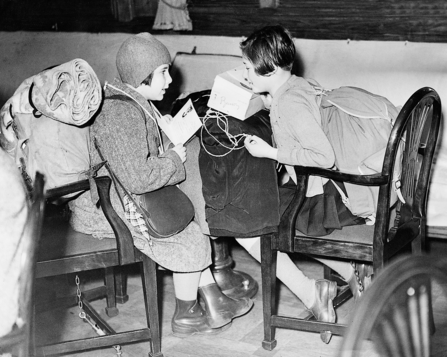Back

Collections
Kindertransport
It's estimated that 10,000 mostly Jewish children were evacuated from Europe through the Kindertransport, the British rescue action carried out nine months before the outbreak of the Second World War. This collection of digitised government documents, held by The National Archives, gives a unique insight into the experience of the Kinder from their arrival to the end of the war.

- Date range
- 1938-1948
- Records
- 1,558
- Images
- 6,116
About this collection
The scanned material is a thorough representation of the central government files, which were transferred to The National Archives relating to Kindertransport. They are not the operational records of the project, and don’t represent a systematic or complete listing of all the children rescued over the period, because it was not a centrally organised or collated effort, but rather an emergency measure to allow unaccompanied children under the age of 17 entry to the UK. The most comprehensive list of the Kinder available has been created by the Association of Jewish Refugees. This list is available through the ‘Making New Lives’ website.
The Kindertransport was a British scheme to rescue Jewish children from Nazi occupied regions in Europe. The first of the Kinder arrived in December 1938. In 1938 conditions for the Jewish community in Europe were rapidly deteriorating through intimidation, segregation and violence. 9 November 1938 became known as Kristallnacht, the night of broken glass. In this collection there is a telegramme from Sir G. Ogilvie Forbes, a foreign diplomat, describing the night: ‘Anti-Jewish rioting on unprecedented scale broke out in Berlin late night on 9th November. All Jewish windows in the principal shopping quarters have been broken and their contents mostly looted. Three synagogues in Berlin are known to have been set on fire. Similar reports are coming in from all over the provinces and further synagogues have been burnt in Munich and Bamberg’ (FO 371/21696).
Following the events of Kristallnacht, Parliament debated on 21 November 1938 and agreed to allow refugee children to be temporarily homed in Britain. The British Jewish community and the Quakers advocated for rescuing vulnerable children and bringing them to Britain. Passport restrictions were waived. Refugee workers both in Europe and in Britain organised visas and transport for children up to the age of 17. There was no one, central organisation behind the rescue efforts. The various groups which did most to organise the rescue missions were:
- The Jewish Refugee Committee
- Central British Fund for German Jewry, re-named Central Council for Jewish Refugees in 1939
- Movement for the Care of Children from Germany, re-named Refugee Children’s Movement in 1939
- Society of Friends (the Quakers)
- Children’s Inter-aid committee (which involved the Save the Children Fund)
- British Committee for Refugees from Czechoslovakia
As part of the rescue, each child had to have a guarantor in Britain to cover the £50 cost of the return trip (equivalent to £2,000 today). The Movement for the Care of Children in Germany, later known as the Refugee Children’s Movement took responsibility for those without a guarantor. Many children stayed with relatives or family friends. Those Kinder not fortunate enough to have contacts within Britain stayed in hostels, lodgings or holiday camps.
The first group of Kinder arrived 2 December 1938. Before leaving their parents, children were dressed in their best and could pack one piece of hand luggage and a suitcase. Some families tried to smuggle out the family valuables. That night, the Dundee Evening Telegraph reported, ‘Two hundred boys and girls arrived at Harwich today. Many of the children are fatherless and motherless, and retain vivid memories of the orphanage where they were sheltered in Berlin being fired above their heads. The refugees are to be provided for at a holiday camp at Dovercourt Bay near Harwich until accommodation can be arranged for them in private houses. Rucksacks over their backs and small handbags contained all the worldly possessions which they clung to as they trooped down the gangway more than two hours after the ship had berthed.’ Before they entered the country they received medical examinations and were deloused.
In September 1939 the Kindertransport ended with the outbreak of war. There were a number of reasons the scheme stopped: The Refugee Children’s Movement was running out of funds, unemployment was rising in Britain and there were growing concerns about bringing ‘enemy aliens’ into the country during a time of war. The records do not stop at the point of arrival in the UK. The Kinder continued to be monitored during the war years, with information on their financial maintenance and religious upbringing being recorded centrally. In 1943, the Guardianship (Refugee Children) Bill was created. The bill was written to mandate that all the refugee children were assigned a guardian in the UK. Prior to the bill the children’s parents were considered the legal guardians but unfortunately for many, their parents’ outcome was unknown or they did not survive. For the children in the care of the Refugee Children’s Movement, Lord Gorell was named as their guardian in England and their ‘tutor’ for children residing in Scotland.
The ultimate goal was to reunite the children with their families after the war, but after the devastation in Europe and the Holocaust this was only rarely possible. For some we find in the records, they went on to employment in Britain, emigrated to USA or Palestine or returned to their homelands
- The National Archives, Kew, London, UK
Try the Social History Archive.